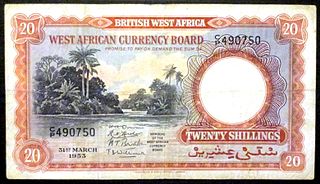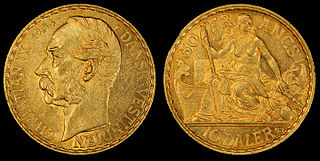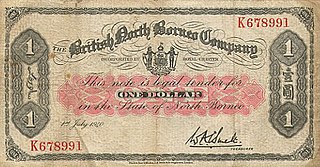The franc was the currency of the Anglo-French Condominium of the Pacific island group of the New Hebrides. It circulated alongside British and later Australian currency. The New Hebrides franc was nominally divided into 100 Centimes, although the smallest denomination was the 1 franc. Between 1945 and 1969, it was part of the CFP franc.

The pound was the currency of British West Africa, a group of British colonies, protectorates and mandate territories. It was equal to one pound sterling and was similarly subdivided into 20 shillings, each of 12 pence.
In 1820, in response to a request from the British colony of Mauritius, the imperial government in London struck silver coins in the denominations of 1⁄4, 1⁄8, and 1⁄16 dollars. The dollar unit in question was equivalent to the Spanish dollar and these fractional coins were known as 'Anchor Dollars' because of the anchor that appeared on them. More of these anchor dollars were struck in 1822 and not only for Mauritius but also for the British West Indies. In addition to this, a 1⁄2 dollar anchor coin was struck for Mauritius. A year or two later, copper dollar fractions were struck for Mauritius, the British West Indies, and Sierra Leone.

The pound was the currency of the Union of South Africa from the formation of the country as a British Dominion in 1910. It was replaced by the rand in 1961 when South Africa decimalised.

The franc was the currency of Cambodia between 1875 and 1885. It was equal to the French franc and was similarly subdivided into 100 centimes. It circulated alongside the piastre with 1 piastre = 5.37 francs. It replaced the tical and was replaced by the piastre. No paper money was issued.

The escudo was the currency of Portuguese Timor between 1959 and 1976. It replaced the pataca at a rate of 5.6 escudos = 1 pataca and was equivalent to the Portuguese escudo. It was replaced by the Indonesian rupiah at an unknown exchange rate following East Timor's occupation by Indonesia. The escudo was subdivided into 100 centavos.

The pound was the currency of the Federation of Rhodesia and Nyasaland. It was subdivided into 20 shillings, each of 12 pence.

The silver real was the currency of the Spanish colonies in America and the Philippines. In the seventeenth century the silver real was established at two billon reals or sixty-eight maravedís. Gold escudos were also issued. The coins circulated throughout Spain's colonies and beyond, with the eight-real piece, known in English as the Spanish dollar, becoming an international standard and spawning, among other currencies, the United States dollar. A reform in 1737 set the silver real at two and half billon reals or eighty-five maravedís. This coin, called the real de plata fuerte, became the new standard, issued as coins until the early 19th century. The gold escudo was worth 16 reales de plata fuerte.

The daler was the currency of the Danish West Indies between 1849 and 1917, and of the United States Virgin Islands between 1917 and 1934.

The British North Borneo dollar was the currency of British North Borneo from 1882 to 1953. It was subdivided into 100 cents. The dollar had remained at par with the Straits dollar, the currency of Malaya and Singapore, at the value of one dollar to 2 shillings 4 pence sterling from its introduction until both currencies were replaced by the Malaya and British Borneo dollar in 1953. Both coins and banknotes were issued by the British North Borneo Company.

The dollar was the currency of the colony of Newfoundland and, later, the Dominion of Newfoundland, from 1865 until 1949, when Newfoundland became a province of Canada. It was subdivided into 100 cents.
The dollar was the currency of New Brunswick between 1860 and 1867. It replaced the pound at a rate of 4 dollars = 1 pound and was equal to the Canadian dollar. The New Brunswick dollar was replaced by the Canadian dollar at par when New Brunswick entered the Canadian Confederation.
The dollar was the currency of British colony of Bencoolen on the west coast of the island of Sumatra until the Anglo-Dutch Treaty of 1824, when the British Empire traded away Bencoolen for Malacca.
The dollar was the currency of Penang between 1786 and 1826. It was subdivided into 100 cents, also called pice, and was equal to the Spanish dollar. The dollar was introduced after the East India Company acquired the island in 1786. In 1826, the Indian rupee was declared legal tender in Penang at a value of 48 pice. The dollar again became the currency of Penang with the introduction of the Straits dollar.
The dollar was the currency of Nevis until 1830. The currency consisted of counterstamped Spanish and French colonial coins. The dollar was subdivided into 72 black dogs, each of 1½ pence. Around 1801, coins were issued for 1, 4, 6, 7 and 9 black dogs with the word "Nevis" and the denomination stamped on them. The 1 black dog coins were countermarked on French Guianan 2 sous, whilst the 9 black dogs were made from Spanish colonial 1 real coins. In 1830, sterling was established as the official currency of the island.
The pound was the currency of New Brunswick until 1860. It was divided into 20 shillings, each of 12 pence, with the dollar circulating at a value of 5/–.

The pound was the currency of Nova Scotia until 1860. It was subdivided into 20 shillings, each of 12 pence. It was equivalent to sterling and was replaced by the dollar in 1860, at a rate of $5 dollars = £1, although coins and notes of the dollar currency were not issued until 1861.
The pound was the currency of Prince Edward Island until 1871. It was divided into 20 shillings, each of 12 pence. It was replaced by the dollar in 1871. Initiall sterling coin circulated, together with locally produced coins and paper money.
The Pitcairn Islands is a non-sovereign British overseas territory and the New Zealand dollar is used as exchange. The Pitcairn Islands began issuing its first commemorative coins in 1988. Though the Pitcairn Islands dollar is not a true currency in the strict sense of the word, and is not used as a circulation coinage, it can be lawfully exchanged as tender. The Pitcairn Islands dollar exists only because of the coin collecting market, which provides a major staple for the island nation. Having a population of only 50 according to the 2020 census, and with only one island in the group of four being populated, there is no need for local coinage. Coins consist of an important part of the Pitcairn Islands' tiny economy and help raise funds for the government's largely fixed and subsidised income.
Niue, a country in free association with New Zealand, uses only one official legal tender currency, which is the New Zealand dollar.









